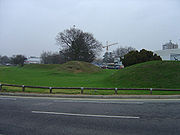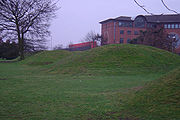
Six Hills
Encyclopedia

Ancient Rome
Ancient Rome was a thriving civilization that grew on the Italian Peninsula as early as the 8th century BC. Located along the Mediterranean Sea and centered on the city of Rome, it expanded to one of the largest empires in the ancient world....
barrow
Tumulus
A tumulus is a mound of earth and stones raised over a grave or graves. Tumuli are also known as barrows, burial mounds, Hügelgrab or kurgans, and can be found throughout much of the world. A tumulus composed largely or entirely of stones is usually referred to as a cairn...
s situated alongside the old Great North Road
Great North Road (Great Britain)
The Great North Road was a coaching route used by mail coaches between London, York and Edinburgh. The modern A1 mainly follows the Great North Road. The inns on the road, many of which survive, were staging posts on the coach routes, providing accommodation, stabling for the horses and...
in Stevenage
Stevenage
Stevenage is a town and borough in Hertfordshire, England. It is situated to the east of junctions 7 and 8 of the A1, and is between Letchworth Garden City to the north, and Welwyn Garden City to the south....
, Hertfordshire
Hertfordshire
Hertfordshire is a ceremonial and non-metropolitan county in the East region of England. The county town is Hertford.The county is one of the Home Counties and lies inland, bordered by Greater London , Buckinghamshire , Bedfordshire , Cambridgeshire and...
, England
England
England is a country that is part of the United Kingdom. It shares land borders with Scotland to the north and Wales to the west; the Irish Sea is to the north west, the Celtic Sea to the south west, with the North Sea to the east and the English Channel to the south separating it from continental...
. They are classed as a Scheduled Ancient Monument
Scheduled Ancient Monument
In the United Kingdom, a scheduled monument is a 'nationally important' archaeological site or historic building, given protection against unauthorized change. The various pieces of legislation used for legally protecting heritage assets from damage and destruction are grouped under the term...
and are protected by law. They form the most complete Roman barrow group in the country. Beside their historical significance, they lend their name to an important thoroughfare in the town (Six Hills Way) and are a local landmark.
History
For almost two thousand years, travellers along the Roman road that eventually became the Great North Road have passed these six large mounds. Their origin and purpose has been the subject of much speculation.Local legend holds that they were the work of the Devil
Devil
The Devil is believed in many religions and cultures to be a powerful, supernatural entity that is the personification of evil and the enemy of God and humankind. The nature of the role varies greatly...
, who, sitting one day looking down on the Great North Road, began to amuse himself by heaving clods of earth at the passers-by. He missed six times and in a temper threw a seventh clod over his shoulder, hitting the spire of Graveley church and knocking it askew. The spire is crooked to this day. The holes in Whomerley Wood show where the Devil dug out his missiles, and the six failed shots lie in a line alongside the road and form the Six Hills.
The Six Hills are almost certainly Roman burial mounds, dating from about 100 A.D., and probably mark the cremated remains of a wealthy local family. The ashes would have been placed in a container along with objects for use in the next world.
No recent scientific archaeological excavation has been carried out on the Hills, but they have all been dug into in the past. These early investigations found only "...a few pieces of wood and a piece of iron...", which were dismissed at the time, but probably were the remains of the original burials. Other reports of damage include the farmer who was carting soil away from the Hills in 1750, and an attempted widening of the Great North Road in about 1820. Over the years, the Hills have all lost over 4 feet (1.2 m) in height.

Mouse-ear Hawkweed
Mouse-ear Hawkweed is a yellow-flowered species of Asteraceae, native to Europe and northern Asia. It produces single, citrus-colored inflorescences. It is an allelopathic plant...
, harebell
Harebell
Campanula rotundifolia is a rhizomatous perennial flowering plant in the bellflower family native to temperate regions of the Northern Hemisphere.In Scotland, it is often known as the Bluebell...
s, whitlow grass, and slender clover, which are not found in the more modern grasslands nearby.

